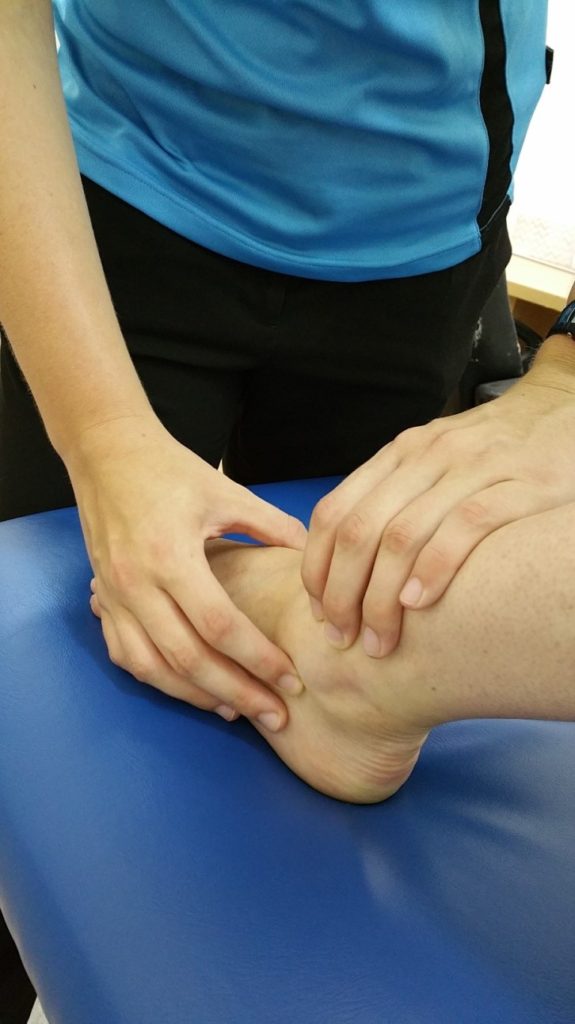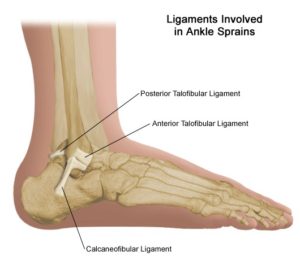Ankle Sprains
Ankle joints and feet are the link between feet are the link between your body and the ground. If you “roll your ankle” as the foot hits the ground, the ankle may be sprained. Physiotherapists can assess your ankle to determine the severity and the type of injury, and improve treatment which promotes healing and recovery. They can offer strategies and exercises to prevent sprains and improve performance.

WHAT IS AN ANKLE SPRAIN?
The ankle joint is made up of four bones shaped to make the joint stable. Increased stability of the joint is provided by ligaments, which are bands of strong, fibrous tissue that guide movement and prevent the joint from moving too much. An ankle sprain occurs when the ligaments are over stretched causing ligament fibres and small blood vessels to tear. Pain, bleeding in the tissues and swelling are the result.
WHAT SHOULD I DO AFTER A SPRAIN?
As soon as possible, and for 72 hours after injury, use the RICE method.
Rest Take it easy and only move within your limit of pain.
Ice As soon as possible, and for 20 minutes every two hours, apply ice or a frozen gel pack wrapped in a damp towel. This helps to control bleeding and pain whilst reducing secondary tissue damage.
Compression Firmly bandage the entire foot, ankle and lower shin. This helps to control swelling.
Elevation As much as possible, elevate your ankle higher than the level of your heart to reduce swelling.
REHABILITATE
Recovery can start very early after an injury. Physiotherapy rehabilitation techniques will help reduce the time that your ankle is painful and movement is restricted so that you can get back to work and sport more quickly. Rehabilitation also facilitates a good quality ligament repair and the return of normal muscle and nerve function.
Avoid any of the HARM factors in the first 48 hours to prevent increased swelling and help your recovery.
Heat, Alcohol, Running, Massage.
HOW PHYSIOTHERAPY CAN HELP
• Your Physiotherapist will examine the injured ankle to determine which ligaments are damaged and to what extent they are torn, and can order an x-ray if needed.
• Early treatment will reduce the swelling and pain, making it easier to walk. Even one treatment and advice can make a significant difference.
• Special techniques called mobilisation help to increase your range of ankle movement so that it is easier to walk and move the ankle. Mobilising the ankle also helps to build a healthy scar in the ligament.
• Your Physiotherapist will show you exercises that are important to improve the strength of the calf and ankle muscles to compensate for the damaged ligament, and give some protection while the ligament is healing.
• Your Physiotherapist will also teach you how to retrain your muscles to react quickly to changes in ankle position to prevent repetitive sprains.


WHEN TO RETURN TO WORK/SPORT
• Your Physiotherapist will discuss the injury with you and estimate the time it will take to recover. The time to full recovery varies from a few weeks to a few months, depending on the severity of ligament damage. Remember that the pain and swelling subsides much faster that the time it takes for the ligament and muscles to regain normal strength. Returning to work or sport too early can delay healing and prolong recovery.
• Your Physiotherapist can teach you how to do special ankle taping or fit you with an ankle brace so that you can return to activity earlier, while protecting the ankle from further damage.
• Your Physiotherapist can help you plan ways to do alternative training so that you maintain fitness and muscle strength while your ankle is healing.
CAN ANKLE SPRAINS BE PREVENTED?
You can reduce the chance and severity of ankle sprains.
• Wear activity-specific well-fitting shoes, use sports strapping tape or an ankle brace to provide good ankle joint support.
• Avoid activities on slippery or uneven surfaces and in areas with poor lighting.
• Keep your leg muscles strong, especially your calf and ankle muscles to help protect the ligaments.
• Practise standing on one leg to challenge your balance responses and the muscles around your ankle.
• Prepare your body for activity by warming up well.
HEALTH REBATES
You may consult a physiotherapist either directly or by referral from your medical practitioner. Most private health insurance funds offer rebates for physiotherapy treatment. Physio For You offers on-the-spot HICAPS claiming.
Some patients are eligible for Medicare rebates for physiotherapy, contact us for more information.
YOUR COMPLIMENTARY COPY SUPPLIED BY:
PHYSIO FOR YOU
Jacqueline Eaton
Director
Ph: 02 4392 1547
Fax: 02 4380 8410
Email: Jacqui_physio@live.com.au

